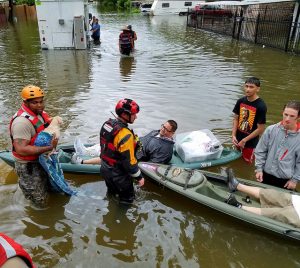
Watching the news on Hurricane Harvey this week brings back some bad memories.
As a pastor, I’ve been through a hurricane in the Houston area: Hurricane Alecia in 1983, a category 3 storm that caused almost 2 billion in damage. And while it didn’t come close to Hurricane Harvey in length, intensity and damage, Alecia taught me many lessons about ministry during catastrophes. Here are some of them.
- Hurricanes are to churches as water is to Alka-Seltzer. If hurricanes bring neighborhoods together, they tend to dissolve congregations. The reason is because hurricanes destroy infrastructure, making transportation and communication difficult. The result is that church members rely on their neighbors much more than they do their church, which often is miles away.
- Even if the church building survives the hurricane intact – and some do not – church attendance and giving immediately drop off. The reason is obvious: people lose their homes and often their jobs and move away. Those who remain focus on repairing the damage to their homes. Often, this takes months, or even years. Consequently, the church, which now has a greatly increased financial need, suffers a decrease in attendance and giving.
- The pastor and pastoral staff have experienced the same destruction as everyone else and often cannot contact members of their congregation. One of the most frustrating things about Hurricane Alecia for me was that I was struggling with a home that had part of its roof torn off, a church building that had part of its roof torn off, while at the same time knowing that my entire congregation was going through the same thing. I felt completely overwhelmed and helpless.
If I had it to do all over again, here’s what I would do.
- Find people in the congregation who survived the storm relatively intact and ask them to start calling or emailing members. Have them prioritize people in terms of need. This would have been impossible to do in 1983 since we didn’t have cell phones and the Internet. But churches can do it now.
- Turn Sunday mornings into church community work times. Instead of meeting for Sunday School, have church members meet at the home of a member with the greatest need at 8 am and work on that home until 10:30 in the morning. (Imagine 30 to 50 people or more working on a flooded home removing carpet and moldy dry wall.) Then go directly to the church at 11 am for a church service – dirty clothes and all. Then follow that up with a pot luck lunch. If you do this, I believe your church will grow closer than it has ever been before.
- Ask a nearby church from outside your affected area to adopt your church. It could help by providing work teams, food and clothing donations for your members and for the community, financial support and pulpit supply.
- Provide a FaceBook page for members to share their experiences.
- Check out available resources for church building repairs. Most churches have insurance and some denominations can also help churches in these situations. One foundation our church used to great benefit was Oldham Little Church Foundation. This foundation provides “completion grants” to small evangelical churches.
My heart goes out to the people of Houston and SE Texas. Life will never again be quite the same for them. But I believe the church, with some simple proactive steps, can bring great healing to that city and in the process grow stronger and more effective.
This post first appeared in NewCommandment.org.
_______________________________________________________________

Learn how to form teams of men for every widow, single mom
and fatherless child in your church at NewCommandment.org.
_______________________________________________________________